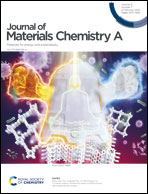Size-tunable MoS2 nanosheets for controlling the crystal morphology and residual stress in sequentially deposited perovskite solar cells with over 22.5% efficiency
Abstract
The two-step crystallization method for perovskite film fabrication has been recognized as an efficient process to obtain high-performance perovskite solar cells (PSCs). However, many issues related to the as-prepared lead iodide (PbI2) film have often been reported. Here, molybdenum disulfide (MoS2) nanosheets with optimized width and thickness via a hydrothermal synthetic method were incorporated into the PbI2 precursor solution, functioning as nano-scaffolds to delay the quick nucleation process of PbI2 and expand the physical volume of the PbI2 film with a nanoporous skeleton morphology. As a result, the penetration of the organic iodide is greatly improved, leading to an optimized surface perovskite crystal orientation with substantially reduced residual stress and trap density. Finally, a champion power conversion efficiency of 22.50% was realized by the MoS2-treated PSCs with improved stability, maintaining 87% of the original performance after 1200 h of ambient storage, 89% of the original performance after 600 h of thermal aging, and 85.1% of the original performance after 73 h of light-soaking aging. This work provides a new way to regulate the two-step crystallization process for fabricating high-performance and stable planar PSCs.



 Please wait while we load your content...
Please wait while we load your content...